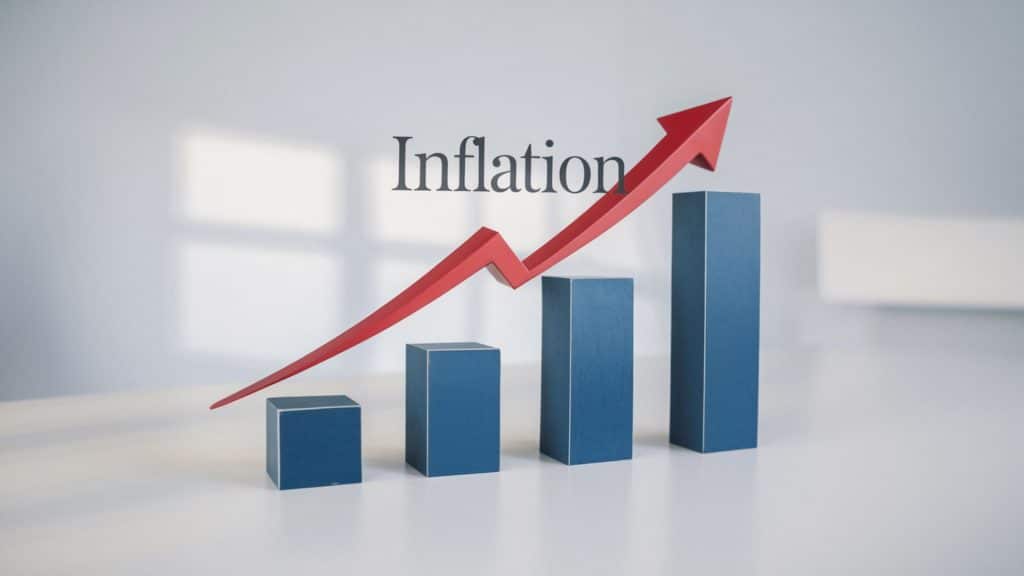Have you ever wondered why that $10,000 sitting in your savings account doesn’t seem to buy as much as it did a few years ago? You’re not imagining things.
The culprit is inflation, and it’s quietly chipping away at your hard-earned money every single day. When prices for everything from groceries to gas keep climbing, your savings lose purchasing power even if the dollar amount stays the same.
This invisible thief affects everyone, but most people don’t realize how significant the inflation impact on savings really is.
What Is Inflation and Why Should You Care?
Inflation is simply the rate at which prices for goods and services increase over time. When inflation rises, each dollar you own buys less than it did before.
Think of it this way: if a gallon of milk costs $3 today and inflation is 3% this year, that same gallon will likely cost about $3.09 next year.
The Federal Reserve typically targets an annual inflation rate of 2%. This might sound small, but it adds up quickly:
- At 2% inflation, your money loses half its purchasing power in about 35 years
- At 4% inflation, that timeline shrinks to just 17 years
- At 6% inflation, your savings are worth half in less than 12 years
- How Inflation Destroys Your Savings Account
Traditional savings accounts are particularly vulnerable to the effects of inflation. Here’s why your “safe” money might not be as safe as you think.
The Real Interest Rate Problem

Most savings accounts offer interest rates ranging from 0.01% to 1%. Meanwhile, inflation often runs much higher. This creates what economists call a “negative real interest rate.”
Real Interest Rate = Savings Rate – Inflation Rate
Let’s look at a real example:
- Your savings account: 0.5% interest
- Current inflation rate: 3.5%
- Real return: -3% (you’re losing money!)
The Compound Effect Over Time
This table shows how $10,000 loses purchasing power under different inflation scenarios:
| Years | 2% Inflation | 4% Inflation | 6% Inflation |
|---|---|---|---|
| 5 | $9,057 | $8,219 | $7,473 |
| 10 | $8,203 | $6,756 | $5,584 |
| 20 | $6,730 | $4,564 | $3,118 |
| 30 | $5,521 | $3,083 | $1,741 |
Higher inflation rates reduce the future value of money, showing the importance of considering inflation in long-term planning.
Which Types of Savings Get Hit Hardest?
Not all savings are subject to the same inflation risk. Understanding which accounts are most vulnerable helps you make smarter decisions.
Below is a comparison of high-risk and lower-risk savings choices to help you make informed decisions.
| Savings Option | Interest Rate | Inflation Protection | Best Use Case | Risk Level |
|---|---|---|---|---|
| Traditional Savings Accounts | 0.01% – 0.50% | Poor | Short-term emergency funds | Low |
| Checking Accounts | 0% | None | Daily transactions, not savings | Low |
| Low-Yield CDs | Fixed, usually below inflation | Poor (locked in) | Short-term goals if rates are acceptable | Low to Moderate |
| High-Yield Savings Accounts | 4% – 5% (variable) | Moderate to Good | Better for medium-term savings and an inflation hedge | Low |
| Money Market Accounts | Competitive, varies by provider | Moderate | Emergency funds with slightly better returns | Low |
While traditional options are safe, they often struggle to keep pace with inflation. To grow your savings responsibly, it’s essential to select accounts that strike a balance between safety, accessibility, and earning potential.
Smart Strategies to Beat Inflation to Save
Protecting your savings from inflation requires a multi-layered approach. Each method plays a role in helping your money keep pace with rising costs over time. Here are proven strategies that work:
1. Diversify Beyond Cash
Treasury Inflation-Protected Securities (TIPS) are government-issued bonds that increase in value with inflation. They offer steady returns, low risk, and are available in different term lengths for flexible planning.
Real estate can grow in value as prices rise, and rental income may increase over time. It also provides ownership of a physical asset that holds long-term value.
Stock market investments have a strong track record of outperforming inflation over time. Shares that pay regular income can offer growing returns, although their values can fluctuate.
2. Maximize Your Current Accounts
Shop for Better Rates
- Online banks often pay 10x more than traditional banks
- Credit unions frequently offer competitive rates
- Don’t settle for 0.01% when 4%+ is available
Consider I Bonds
- Government savings bonds that adjust for inflation
- Currently paying attractive rates
- Limited to $10,000 per person annually
3. Create an Inflation-Fighting Emergency Fund
Your emergency fund needs special attention during inflationary periods. Aim to keep 3 to 6 months of essential expenses in a high-yield savings account, where your money can earn interest while staying accessible.
To improve returns without sacrificing too much liquidity, consider laddering a portion of your emergency fund in short-term CDs.
Lastly, review and adjust the total amount each year to ensure it keeps up with inflation and rising living costs.
When Inflation Actually Helps Your Finances

Surprisingly, inflation isn’t always your enemy. Inflation can actually work in your favor when it comes to certain financial aspects.
With fixed-rate debt like a mortgage, your monthly payments stay the same even as prices and, ideally, your income rise. Over time, this reduces the real cost of your debt, making it easier to manage.
Even credit card debt can feel less burdensome in inflation-adjusted terms, though it’s still best to pay it off quickly.
On the income side, many jobs offer cost-of-living adjustments, and career growth can often outpace inflation. Additionally, side hustles or freelance work may scale more easily with rising prices, helping you stay ahead financially.
Building Your Anti-Inflation Action Plan
Here’s your step-by-step guide to protecting your savings:
Immediate Actions (This Week)
- Move money to high-yield savings (Earn 4%+ instead of 0.01%)
- Research I Bonds (Buy up to $10,000 annually)
- Calculate your real returns (Know if you’re losing money)
Medium-Term Steps (Next 3 Months)
- Open investment accounts
- Research TIPS
- Review all accounts
Long-Term Strategy (Ongoing)
- Diversify investments – Spread money across asset classes
- Monitor inflation trends – Adjust strategy as needed
- Increase earning power – Invest in skills and career growth
The Bottom Line
Inflation is a fact of life, but it doesn’t have to destroy your financial future. Your savings account might feel safe, but if it’s earning less than inflation, you’re actually losing money every year.
The good news? You have plenty of options to fight back.
High-yield savings accounts, I Bonds, TIPS, and smart investing can all help your money maintain its purchasing power over time. The worst thing you can do is nothing at all.
Start with small steps today. Even moving your emergency fund to a high-yield account can make a meaningful difference over time.
For more information related to the economy, check our website.





































